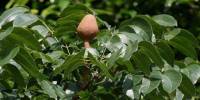In Vivo Evaluation of CNS Depressant and Antinociceptive Activities of Different Extracts of
Trewia polycarpa Leaves
Abstract
Recently worldwide different researches on medicinal plants have grabbed attention. A number of experiments were found where medicinal plants have been used for different complementary and traditional systems to promote newer and safer drugs. Keep this in mind our current study was designed to find out CNS depressant and analgesic principles from different solvent extracts (Ethanol-ETTP, Chloroform-CHTP, Ethyl Acetate- EATP) of leaves of Trewia polycarapa.
After completing phytochemical screening tests, we have noticed that the plant is a good reservoir of such compounds which have the possibility to be a better source of CNS depressant and analgesic therapeutic agents in living organism.
In our present study, we have checked above mentioned pharmacological activities of our experimental plant extracts in rodents. By the open field and hole cross method, CNS depressant activity was inspected with the decline of locomotor activity on mice. Analgesic activity was evaluated by acetic acid induced pain method as well as formalin induced pain method. Here crude extracts were administered to mice at a dose of 250mg/kg and 500mg/kg. All the results of our experiments were statistically significant (p<0.05). In CNS depressant activity tests, the movement of rodents decreased in a dose depending manner comparing to the standard diazepam. The experimental extracts also gave good analgesic effect comparing to control group and represented by decreased amount of writhes in acetic acid induced pain method as well as reduced licking time in formalin induced licking method. At 500 mg/kg dose, the ETTP extracts showed 60.24percent inhibition of writhing response compare to standard or reference indomethacin where 68.42 percent inhibition was observed. In conclusion we can say that our present findings suggest that ETTP, CHTP and EATP extracts of Trewia polycarpa leaves contain potent CNS depressant as well as analgesic therapeutic active principles.
General introduction
Plants are very important element of whole world. Human has been using plants as medicine from ancient times. Plants were identified as source of medicine after different type of observations and experiments. Hence in the early stage of human civilization, treatment with various plants began (Malik, 2001).
The empirical uses of medicinal plants are as old as human civilization which can be traced into ancient documents (Hamburger and Hostettmann, 1991). The past decade has witnessed that how the plants can be benefited to human. Also, they observed that the undesirable side effect of the plants as medicine is minor. So, now-a-days modern people are grabbing their attention more towards the herbal medicine rather than the synthetic drugs. These commercial drugs are very expensive to develop as well as contain toxic effect. WHO says that 70% population of world relies on plant for primal health care. From tropical plants, more than 50 major drugs are originated in global market (Ghani, 2003). 17% of higher plants from about 250,000 species have been investigated for medical potential around the whole world. The diversity of plants gives a limitless source for the application in the progress of latest drugs. The lead molecules which are isolated from medical plant can act as alternative medicine.
The people of underdeveloped continent like Asia, Africa and Latin America are backward and lack inventiveness as well as accepting western technology and civilization without active response. These 3rd world, earn money by importing herbal medicine. Therefore, this medicine is a call to fight against all obstacles (Adodo, 2013). In South Asia, Bangladesh is a country which is situated on the fertile Bengal delta. The fertile land of Bangladesh made it an excellent source of medical plants.
Rural people of Bangladesh greatly depend on different medicinal plants for primary health care. But most of the medicinal plants did not undergone studies. Approximately 450 to 500 of such medicinal plants name so far have been enlisted as growing or available in Bangladesh (Ghani, 2003). In Bangladesh, the medicinal plants are used as semi-processed as well as raw forms of medicine in around 204 Ayurvedic, 297 Unani and 77 Homeopatheic drug manufacturing industries. These plants also serve as important raw materials for any modern medicinal preparation. The market value of drugs produced by these industries from medicinal plants is about the 300 crores. (The Daily Jugantor, 21 June, 2003).
Medicinal plant
Medicinal plants are those whose barks, seeds, leaves, fruits etc are used for medicinal purposes as well as different chemical compounds are synthesized from the plant for performing biological functions. Examples of medicinal plant include Tulsi, Aloe Vera etc.
For the definition of medicinal plant, a great number of definitions have been proposed. The formulated definition of medicinal plant with which World Health Organization agrees is:
A plant whose organs containing chemical constituents or substance can be used for therapeutic purpose is called medicinal plant. Alternatively, this plant can act as precursor for the synthesis of other drugs.
A Glimpse on the history of Medicinal plant:
The history of plant and herbs in medicine is mainly the history of medicine. For many years, they have been playing a great role in healing process. From the origin of medicinal plant, they were connected with religion. They were also key factors in the cultural life of many societies. At present, they have become a part of both the art and science of medicine.
Ancient Times:
Nobody knows that exactly when medicinal plants were used for the first time. Most medicinal plants discoveries occurred as a result of search of new type of food. Knowledge on the plant is transmitted through orally.
Recorded History:
It is known that first written text on the use of medicinal plant is about 5,000 years old. It was written by Sumerians, in ancient Mesopotamia (now Iraq). Ancient Egyptian wrote the Ebers Papyrus 3,500 years ago. This was full of information on medicinal plants including garlic, juniper, cannabis, castor bean, aloe vera etc.
Ancient India:
The historical evidence of ancient Indian culture and medicine is documental in different writings, the Vedas, namely Rgveda, Samaveda, Yajurveda and Atharvaveda. The comprehensive Indian verbal, the “Charaka Samhita” contains 341 medicinal plants (Ali, 1994).
Ancient China:
The Pen Tsao is the first Chinese herbal which was written by Chi’en Nung, the Chinese Emperor. This book contained more than 300 medicinal plants and their uses. It includes Chinese ephedra which is still widely used today.
Golden Age:
Greeks and Romans: From the 1400s to 1600s is referred as the “Golden Age of herbalism”. The Greeks and Romans got much of herbal knowledge from their early civilization. The Greek physician Hippocrates is referred as the “Father of Modern Medicine”. Aristotle compiled list of medicinal plants. Theophrastus is Aristotle’s star pupil. He is the father of Botany. Islamic Golden Age: During the Arab Islamic golden age, various works by physicians and scientists raised the dignity of medical profession. Baghdad and Cordoba became the main centers for Arab development of herbal medicines. Al-Zahrawi wrote a book and the name is the Book of Simples. For European herbal medicine, this book is essential source. The botanist Abu Al-Abbas al-Nabafi, Ibn al-Baitar, Abu Rayhan Biruni, Ibn Zuhr, Daoud al-Antaki had also contributions for the development of herbal medicine.
Herbalism today:
In past, herbalism was mixed with magic and superstition. But today, people can determine that what is superstition and what is fact. The plants which contain curative power have been put to the scientific test. That is why interest in herbalism is improved today. Medicinal plants are often more effective and safe than the costly drugs. Today, we truly have the best of both worlds.
Importance of medicinal plant
Because of the presence of different chemicals, plants show medicinal effect. Therefore, the medicinal plants are used in pharmaceutical, food, agricultural and cosmetic industry. The presence of primary metabolites like carbohydrates, fats and proteins in plants serve a variety of purposes indispensable for nutrition and reproduction. Plants also produce secondary metabolites which protect the plants against bacteria, fungi, animal etc. These metabolites play a crucial role in curing diseases. Chemicals that make a plant valuable are: tannins, glycosides, volatile oil, alkaloid, fixed oils, gum resins, vitamins and minerals.
- Alkaloids are naturally occurring chemical compounds which has addictive or pain killing or poisonous effect and sometimes also help in important cures.
- Glycosides are organic natural compounds which is present in lots of plants. It is used as heart stimulant or drastic purgative.
- Tannin compounds are widely distributed in many species of plants. It is used for gastro intestinal problems.
- Volatile oil is used as antiseptic. It also enhances appetite.
- Fixed oil decreases acidity.
- Gum-resins contain analgesic property.
Table: A list of some medicaments which are obtained from plants
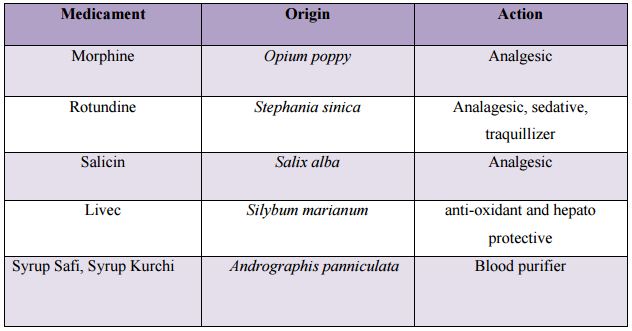
Medicinal plant in Bangladesh
Bangladesh is adorable storage place of various medicinal plants. Recently the medicinal plant has drawn attention of the botanists. The Ministry of Health took the initiative step and for that medicinal plants have been planted in government hospitals and clinics for first time as a part of National Tree Planting Programme. Many researchers have done different researches on different era of medicinal plants {Ghani (2003), Yusuf et al. (1994), Uddin et al. (2001)}. Traditionally these plants are collected from forest and wild area although no systemic effort was taken for the improvement of the cultivation practices of these plants.
Plant Review
Trewia polycarpa
Trewia polycarpa is a plant of the family Euphorbiaceae and genus of Trewia. It is distributed in different parts of the districts on canal and river bank of Bangladesh. Pittali or Medda is another name of this plant which is known by local people. This is a common plant as well as grown naturally in different parts of Bangladesh (Ghani, 2003).

Figure: Leaves of Trewia polycarpa
Scientific Classification
- Kingdom :Plantae
- Division :Angiosperma
- Class :Eudicots
- Unranked :Rosids
- Order :Malpighiales
- Family :Euphorbiaceae
- Subfamily : Acalyphoideae
- Tribe :Acalypheae
- Subtribe :Rottlerinae
- Genus :Trewia
- Species :Trewia polycarpa (Jackson, 1994)
Synonyms and Different names:
Trewia polycarpa is familiar in different names at various places. They are:
Synonyms: T. nudiflora L.
Bengali: Latim, Lattu, Medda, Bhatam, Pitali, Panigambhar, Meragota; Mera, Gotagamar (Sylhet).
Tribal Name: Bol-diktak, Bolno-khap (Garo); Hruprukban (Mogh); Chagalla-dibhangor (Chakma); Rin Moro (Marma); Pitagola (CHT).
Sanskrit: Shriparni, Tumri, Pindaara
English: False white teak, Gutel
Hindi: Gori Gambhara
Malyalam: Nevkumizhu
Description
Trewia polycarpa plant can be around 15 meter tall. The plant is deciduous, dioecious type and found in moist deciduous forest. Leaves are opposite and that is 15 to 23 centimeter long. Also the leaves are oval, heart shaped and pointed. The male and female flowers are in separate and distinct individuals with zero petals. Female flowers are green and male flowers are yellow in color. The length of the male and female flower is 7.5 milimeter and 10 to 20 centimeter respectively. The plant seeds are rounded at both ends and the surface of bark is smooth (Uddin, 2010).
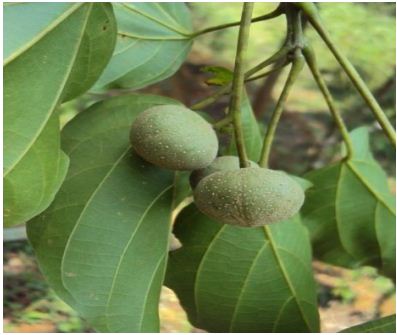
Figure : Trewia polycarpa fruits
Medicinal uses
- Stems and barks are used as anti toxic and in toothache at Brindabonpara village, Bogra. For the treatment of enlarged thyroid, bark is used.
- The leaves as well as its abstract obtained by decocting are used in treating injuries.
- Root’s decoction is applied to cure rheumatism and gout.
- Leaf of this plant is used as fodder (Joshi and Singh, 2010).
Chemical Constituents:
According to Rastogi and Mehrotra 1990, Pentacyclic triterpene ketone, tetraxerone, beta sitosterol and nudiflorine are the constituent of bark. Also this plant contain high total phenolic content (89.8- 107.8 mg/g) and high antioxidant (84.8-96.9%) (Prakash et al., 2007). Seeds have an alkaloid ricinidine, a maytansinoid compound, trewiasine (Shilpi et al., 2010). It showed signifiant cytotoxic activity at human cell lines in vitro (Powell et al., 1983).
Plant part utilized in the study
For the present study, Trewia polycarpa leaves extract was used for pharmacological investigation.
Goal of the investigation
For the treatment of new diseases and the existence diseases, different drugs are required as well as also identified. We have noticed that human body have become resistant to drugs which are available in market. Also because of using synthetic drugs, various toxic and side effects occur.
So recently, curiosity has grown in world for herbal medicines which are obtained from medicinal plant. So we have selected Trewia polycarpa leaves for study because of its medicinal uses.
After doing this investigation, it was proved that our experimental plant may contain more bioactive compounds.
If elimination of poisonous compound is possible from this plant, then this experimental plant can be used for the treatment of various diseases. The current investigation was done to isolate CNS depressant and analgesic activities.
Present Study Protocol:
Present study was designed so that the medicinal effect of different extract of Trewia polycarpa plant can be observed. The study protocol consists of following steps:
- Preparation of Trewia polycarpa leaves extract
- Phytochemical screening of the plant.
- Screening of CNS depression activity of crude extracts on Swiss albino mice.
- Screening of analgesic activity of crude extracts on Swiss albino mice.
Methods & Materials
Preparation of Plant Extract (Trewia polycarpa)
Collection and identification:
The fresh leaves of the plant Trewia polycarpa were chosen for pharmacological investigation. Leaves of Trewia polycarpa were collected from Natore, Rajshahi. Later it was recognized by National Herbarium, Bangladesh (accession number 4500) and verification was done by Associate Professor Dr Mahbubur Rahaman, Botany Department of Rajshahi University.
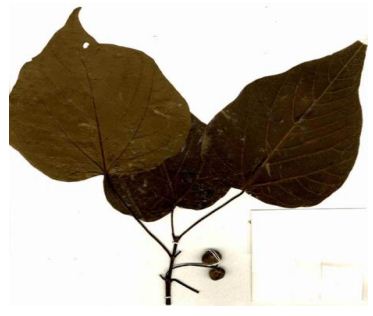
Figure: Dried Leaves for recognition by Herbarium
Preparation of Plant samples:
The experimented plant leaves were separated from undesirable plant parts and dried in the sun shed for 5 days. After completion of drying, dried leaves were pulverized into coarse powder by suitable grinding machine. Powders were kept in clean airtight glass containers for further use.
Here the grinder was properly cleaned so that contamination with previous ground material on other foreign matter can be avoided. The weight of leaf powder was 364.86 gm. Finally it is placed in dry and cool area until experiment begins.
Extraction of powdered samples:
A glass jar was washed properly and then rinsed with ethanol as well as dried. After that the dried leaves powder were put into the jar and ethanol was poured into it up to 1 inch height above the sample surface. The container was sealed with its content and kept for 4 days with occasional shaking and stirring. This shaking was done to get better extraction.
Fractionation of the extracts:
For fractionational extraction, customized Kupchan partitioning method (Van Wagenen et al., 1993) was followed. For that Trewia polycarpa extracts were filtered by using sterilized cotton plug followed by filter paper. Here the cotton was rinsed with ethanol and then adjusted inside the funnel. After the extraction process, 400ml extract was found, among these 200ml extract was kept in one beaker and the other 200ml extract was kept in another beaker. Then the contents of both beakers were separately evaporated by rotary vaccum evaporator (RE200 Sterling, UK) up to 20 ml.
After that separating flask was rinsed with ethanol and 20ml of extract was poured into the flask and around 40ml of n-hexane was mixed with the extract. Then the flask was shaken for 15 minutes. In the meantime the stopper of the flask was opened several times so that the gas which was formed inside the flask released easily. Then the mixture was separated. Here, the pure upper layer of the extract was collected which is n-hexane extract. This procedure is repeated for three times.
The remaining extract was then treated with chloroform in separating flask and above mentioned procedure was followed again. But here we have collected the pure lower layer. This extract is chloroform extract.
Finally the remaining extract (upper layer) was mixed with double amount of ethyl acetate in separating flask. Then shaken for 15 minutes; and collected the pure lower layer by using separating flask. This was ethyl acetate extract.
After completion of fractional extraction all the extracts were concentrated by evaporating the solvent and the extracts of ethanol, chloroform and ethyl acetate which were chosen for investigation were labelled as-ETTP, CHTP and EATP respectively.
Drugs:
Diazepam and Indomethacin were used for current study which was supplied from Square Pharmaceuticals Ltd, Bangladesh.
Phytochemical analysis:
By using standard procedure, the plant extract were introduced to phytochemical screening (Trease and Evans, 2001).
Experimental animal:
For the pharmacological investigation 176 Swiss albino mice were collected from animal Lab of Jahangirnagar University and ICDDRB, Bangladesh. The average weights of the mice were 29 to 34 gm. Standard environmental situation was maintained to keep the mice. The condition was 55-65% relative humidity, 12 hours light/dark cycle and 24.0±0°C temperature. Also sufficient amount of food and water was supplied all the time.
Ethical approval:
Institutional animal ethical committee accepted the guidelines which were followed for animal test (Zimmermann, 1983).
Pharmacological investigation of plant extracts:
The following pharmacological investigations were done to determine the medicinal effect of the experimented extracts:
- CNS depressant activity and
- Analgesic activity
Study of CNS Depressant effect of ETTP, CHTP and EATP extracts:
CNS Depressant drugs are the agents which slow down the activity of brain. These types of drugs are prescribed by doctor for the treatment of panic attack, anxiety, insomnia etc. Mostly CNS Depressants activate GABA neurotransmitter. This helps in decreasing brain activity.
The CNS depressant action of Trewia polycarpa plant extracts were observed by comparing with the standard diazepam in the experimented rodents. CNS depressant activity was determined by using two techniques. They are:
- Open field technique
- Hole cross technique
The Design of the CNS depressant Experiments:
In both methods 40 mice were chosen randomly and then divided into 8 groups. They were group G1 to G8 where 5 mice were in each group. A particular treatment was given to each group. Before this specific treatment, weight of every mouse was measured accurately as well as marked. Also the dosage of the sample and standard were also settled according to body weight.
- Group-G1- 1% Tween 80 in water
- Group-G2- Standard (Diazepam)
- Group-G3- ETTP 250 mg/kg
- Group-G4- ETTP 500 mg/kg
- Group-G5- CHTP 250 mg/kg
- Group-G6- CHTP 500 mg/kg
- Group-G7- EATP 250 mg/kg
- Group-G8- EATP 500 mg/kg
Reagents, Chemicals and Equipments
Table: Reagents, Chemicals and equipments used for CNS depressant test

Preparation of drug and chemical solution:
At first standard which is considered to be diazepam at 10 mg/kg dose was prepared. Then required amount of diazepam was dissolved with saline water (0.9% NaCl) and 0.5 ml of suspension was given to each mouse orally.
Crude extract was also prepared at a dose of 250mg/kg and 500mg/kg by body weight of mice. Then doses were measured as well as small amount of tween 80 was added to every preparation. Then saline solution was added slowly. When the final volume was made then 0.5 ml of preparation was administered to each mouse.
Table: Test samples used in the estimation of CNS Depressant activity of Trewia polycarpa Plant
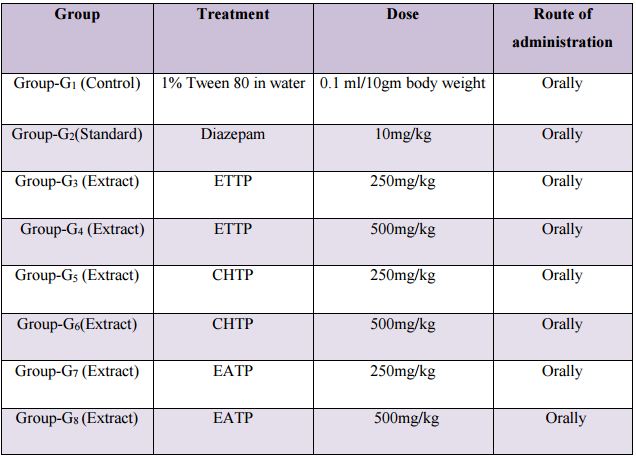
Open field test
Gupta’s open field method (Gupta et al., 1971) was followed to carry out Open field test. The box was half square meter as well as divided into squares each. On the other hand the box was black and white colour like a chess board. The apparatus had a wall which was 40cm in height. For 3 minutes, each square was counted which was visited by mice. Also, during the study period, several results were taken on 0, 30, 60, 90 and 120 minutes.
Analgesic activity of Trewia polycarpa plant extracts:
Drug which is used to relieve pain is called analgesic drug. These drugs are also known as painkiller. The analgesic test was done by two methods. These two methods are:-
- Acetic acid induced writhing technique
- Formalin induced pain technique.
At first mice were weighed and after that categorized into 8 groups where 5 mice were in each group. Later by a special needle, test samples and standard were administered to mice at 0 hour
After that we counted the number of movements of mice from one compartment to another at zero hour for three minutes.
Eventually after 30, 60, 90 and 120 minutes the number of times all the mice traveled from one compartment to another was counted for a duration of 3 minutes and afterwards the data was recorded for the three extracts of our plant.
Design of the analgesic experiments:
Forty eight mice were chosen anyway and divided into 8 groups where the groups were from G1 to G8 as well as 6 mice were in each group. Each group got a specific treatment. Before the treatment, each mouse were weighed properly as well as marked. Then the dosage of the test sample and control materials was also settled according to body weight.
- Group-G1- 1% Tween 80 in water
- Group-G2- Standard (Indomethacin)
- Group-G3- ETTP 250 mg/kg
- Group-G4- ETTP 500 mg/kg
- Group-G5- CHTP 250 mg/kg
- Group-G6- CHTP 500 mg/kg
- Group-G7- EATP 250 mg/kg
- Group-G8- EATP 500 mg/kg
Acetic acid-induced writhing technique:
Acetic acid induced writhing test is a technique where analgesic behaviour is observed. In this method (Ahmed et al., 2001) intra-peritoneally acetic acid was administered to the mice so that pain sensation generates. Here, indomethacin was considered as standard. At first the normal saline, extracts at a dose of 250 mg/kg and 500 mg/kg as well as standard drug were administered orally. After 30 minutes, the solution of 0.7% v/v acetic acid was administered intraperitoneally. After administration of solution of acetic acid, no writhing was counted for 5 minutes. After 5 minutes, writhing was counted for 15minutes. For that each mouse was placed on observation table and noticed the number of writhing of mice. The mice did not give full writhing all the time. They gave half writhing also. So, two incomplete writhing were counted as one complete writhing.
Preparation of drug and chemical solution:
For the preparation of standard which is indomethacin at a dose of 10 miligram/kg, specific quantity of this drug was suited. After that it was dissolved in 0.9% saline water. Then at the amount of 0.5 ml, each mouse was administered standard orally.
Crude extract was prepared at a dose of 250 miligram/kg and 500miligram/kg according to body weight manner of mice. For that, doses were measured and then suspending agent tween 80 was added to each preparation and then mixed. After proper mixing of these two, saline water was also added and final volume was also made. Then 0.5 ml was administered to each mouse.
Results and discussion
Results of CNS Depressant activity of plant extracts on mice
For the analysis of CNS depressant activity, the open field method and hole cross method were followed according to Gupta’s method (Gupta et al., 1971) and Takagi’s method (Takagi et al., 1971) respectively. Both tests were done on mice to find out CNS depressant activity. The results of these two methods are shown below:
Results of Open Field method
At 250 mg/kg and 500 mg/kg dose, experimental leave extracts were administered to mice. As a result, the movements of mice were reduced in a dose depending manner. Also, it was comparable with diazepam (standard). This movement lowering effect of extract on mice was observed at 30 min interval from zero minute up to 120 minutes. The extracts caused reduction in movement and this may be connected to CNS depression, as reduction or depression of movement is common to most antipsychotics.
Table: Data of CNS Depressant activity test of Trewia polycarpa plant extracts by Open field method:
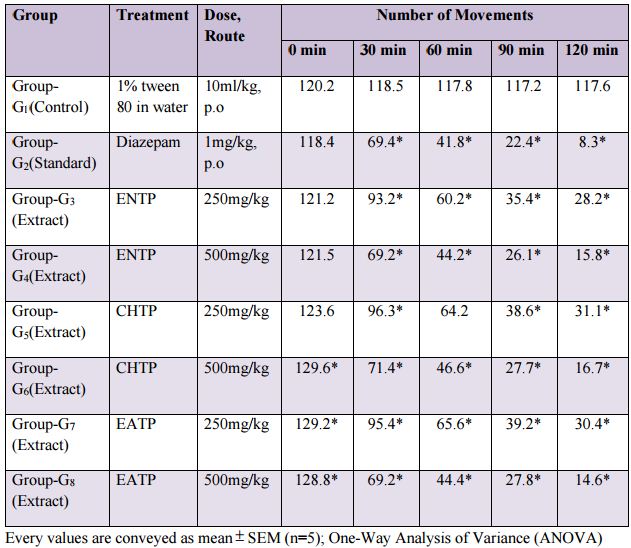
Results of Hole Cross method:
In this technique, the leaves extract at 250 mg/kg and 500 mg/kg dose showed continuous decrease of movement in the experimental animals from the second observation to last observation. Here, in dose depending manner, significant results were obtained.
Table: CNS depressant activities of extracts ETTP, CHTP and EATP in rats by hole cross method
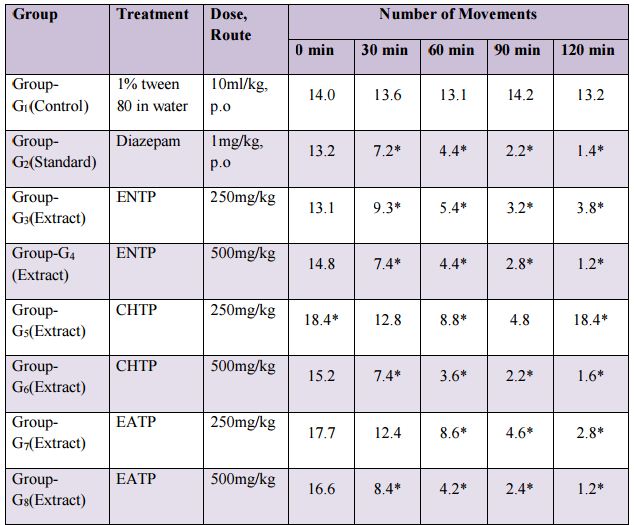
Every values are conveyed as mean SEM (n=5); One-Way Analysis of Variance (ANOVA) trailed by Dunnet’s test. *P<0.05 significant evaluated to control
Results of Analgesic activity of plant extracts on mice
For the experiment of analgesic activity, two methods were followed. They were acetic acid induced writhing method and formalin induced pain method
Acetic acid induced writhing test (peripheral pain)
In this test, the antinociceptive effects of plant Trewia polycarpa were investigated by administering 250 mg/kg and 500 mg/kg dose to rodents. By applying this test, it was seen that there was significant effect of plant extract compare to standard drug (Indomethacin). Among the samples of crude extract, group G4 showed better results compare to the standard which was ethanol (ETTP) 500mg/kg in dose depending manner.
Discussion:
For the production of commercial drugs or in the improvement of lead compounds, it has been built that medicinal plants are good reservoir of it. Narcotics or non-narcotics (NSAIDs) drugs are employed for the pain management. However these drugs have toxic effects also (Park et al., 2004). Most of the drugs that are used for depression affect the quality life of sick person.
Oppositely, herbal medicines have less toxicity, good absorption and have a lower side effect profile. So, this has been used since very old times (Li et al., 2003). Hence it is necessary to create efforts to represent the new medicinal plants for production of cheaper and less toxic drugs.
Firstly phytochemical screening of plant extract was done where tannins, alkaloid, glycosides, saponins etc were noticed. From the other journals it was seen that plants which contain these types of constituent shows medicinal effects. So there is a possibility that it may contain medicinal effect. That’s why a number of experiments have been done on the plant extract of
Trewia polycarpa to determine its CNS depressant and analgesic activity on mice. From the results, it was seen that the plant extract contains both analgesic and CNS depressant activity. From the analgesic activity results, it was clear that extracts could decrease the number of writhing considerably and showed antinociceptive action. In order to make sure whether this antinociceptive action was central or peripheral, formalin test method was also followed. This formalin test consists of two phases. Because of direct action of formalin in sensory nerve, the pain began in early phase. As a result of different inflammatory mediators, pain induced in late phase. The result which was obtained here showed that the plant extracts mainly inhibited late phase mechanism of pain. So, it was suggested that it may act like steroids and NSAIDs. But this inhibition of pain may also occur due to phytochemical constituents which is present in the extract of the experimented plant though the actual mechanism of action was not investigated here.
Alertness is the result of increased locomotor activity and sedative effect is the result of decrease in locomotor activity. In this investigation, locomotor activity was observed by two methods: open field and hole cross tests. The standard (diazepam) was used in this study to induce sleep as well as believed that it act on the binding site of GABA receptors. It has been reported that flavanoids and other steroids act as ligands for GABA receptor in CNS (Dal et al., 2012). So, there is a chance that presence of flavanoid in the extract may be responsible for its CNS depressant activity.
From our best knowledge, this is the first report of CNS depressant and analgesic activity of Trewia polycarpa leaves. Now it can be concluded on the basis of results obtained from investigation that the plant may be useful as CNS depressant and analgesic agent. But our work was only preliminary effort. It will require additional detailed advanced investigation.
Conclusion
From the thousands of years, nature is giving us medicinal gift which act as natural source of modern drugs. One of those gifts is Trewia polycarpa which contains pharmacological activity. To examine the pharmacological activity, a number of experiments are done. Among them one is analgesic test (acetic acid induced writhing method as well as formalin induced pain method) and the other is CNS depressant test (open field method and hole cross method) which was compared with the standard indomethacin and diazepam respectively. After observing the results of recent study, it can be said that ETTP, CHTP and EATP extracts of our experimental plant leaves at dose of 250 mg/kg and 500mg/kg showed significant(p<0.05) analgesic and CNS depressant activity compare to control group.
So it is clear that our experimental plant on which we worked is helpful plant and our work was only preliminary effort which will require further comprehensive exploration as well as depiction of active compounds and necessitates preformulation studies for expansion of a potential dosage form.




